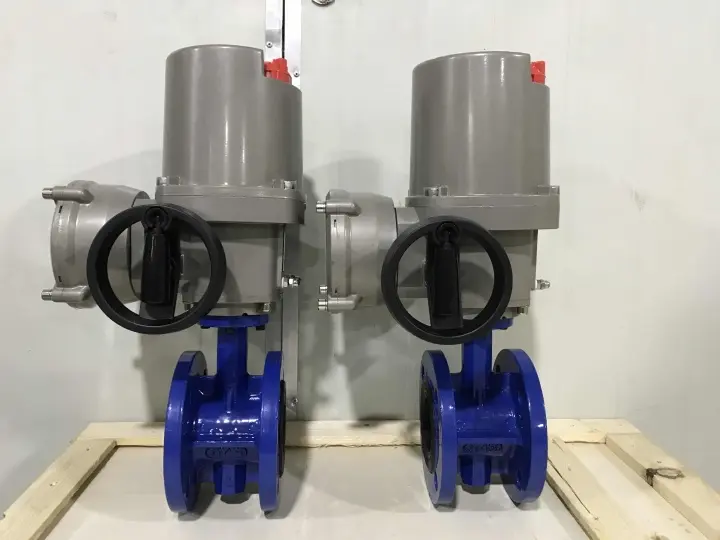I. Product Introduction
The Metal Seat Segment Ball Control Valve, also known as Eccentric Rotary Control Valve, is a high-performance industrial control component designed for precise regulation of fluid media in harsh operating environments. It integrates the structural advantages of segment ball valves and eccentric rotation mechanisms, with a metal-to-metal sealing system as its core feature, making it significantly superior to traditional soft-sealed control valves in handling extreme conditions.
Unlike full-port ball valves, this valve adopts a segmental ball design that rotates eccentrically around the stem axis. When operating, the segmental ball only makes linear contact with the metal seat during the key sealing stage, minimizing friction and wear while ensuring tight sealing. The all-metal seat structure, combined with advanced surface treatment technologies, enables it to withstand high temperatures, high pressures, abrasive media, and corrosive substances, making it widely applicable in industries such as oil and gas, petrochemicals, power generation, metallurgy, and mining.
Its core function is to accurately adjust the flow, pressure, and temperature of media by receiving control signals from the actuator, ensuring stable operation of industrial processes. Whether in high-frequency switching scenarios or long-term continuous operation conditions, it maintains excellent control precision and operational reliability, providing critical process control support for high-demand industrial systems.
II. Product Features
1. Superior High-Performance Sealing
The valve features a metal-to-metal sealing structure between the segmental ball and seat, with the sealing surfaces typically enhanced by advanced coating technologies such as High Velocity Oxygen Fuel (HVOF) spraying, Plasma-Transferred Welding (PTA), or laser cladding . This design achieves reliable gas-tight sealing even under extreme temperature and pressure fluctuations, with leakage performance meeting Class IV standards and above . Compared to soft-sealed valves, it avoids sealing failure caused by high-temperature aging or chemical corrosion, ensuring long-term sealing stability.
2. Excellent Resistance to Harsh Conditions
With a wide operating temperature range of -196°C to +600°C, it can handle both cryogenic media and high-temperature fluids such as superheated steam . The maximum working pressure reaches up to 400 bar, fully complying with ANSI Class 150#-1500# pressure ratings . The metal seat and segmental ball, made of high-strength materials like 316 stainless steel with nickel-based alloy coatings (Ni 55/Ni 60), exhibit exceptional wear resistance and corrosion resistance, effectively resisting erosion from abrasive media such as slurries and solid particles .
3. Precise Flow Control Performance
The eccentric rotation mechanism and optimized segmental ball profile create an approximate equal percentage flow characteristic, with an adjustable ratio of up to 100:1 . This enables precise control of media flow across the entire adjustment range, especially suitable for processes requiring strict flow regulation. The Cv value range covers 5.6 to 1900, meeting the control needs of both small-caliber precision adjustment and large-caliber high-flow scenarios .
4. Durable and Low-Maintenance Structure
Adopting split body or two/three-piece body construction, the valve allows easy disassembly and maintenance without removing the entire valve from the pipeline . The blow-out proof stem design complies with API 608 standards, preventing stem ejection due to abnormal pressure increases and enhancing operational safety . The reduced friction between the eccentric segmental ball and seat significantly extends the service life of sealing components, reducing maintenance frequency and operational costs .
5. Versatile Customization and Compliance
A variety of body materials are available, including carbon steel, 316 stainless steel, duplex stainless steel, and nickel-based alloys (Hastelloy® C276, Inconel®) to adapt to different corrosive media . Connection forms cover RF (Raised Face) and RTJ (Ring Type Joint) flanges, as well as wafer-type connections, compatible with mainstream pipeline standards . It fully complies with international standards such as ANSI B16.34, API 607, API 598, and NACE MR-1075, meeting the quality requirements of global industrial markets .
III. Technical Data
|
Technical Parameter
|
Specification Details
|
|---|---|
|
Valve Type
|
Metal Seat Segment Ball Control Valve (Eccentric Rotary Type)
|
|
Nominal Diameter
|
1/2″~12″ (DN15~DN300); special sizes available on request
|
|
Nominal Pressure
|
ANSI 150#~1500#, JIS 10K~40K, PN 10~40MPa
|
|
Operating Temperature Range
|
-196°C~+600°C (varies with material and sealing configuration)
|
|
Maximum Working Pressure
|
Up to 400 bar
|
|
Body Material
|
Carbon steel (ASTM A105), 316 stainless steel (ASTM A182 316), duplex stainless steel, Hastelloy® B/C, Inconel®, Zirconium
|
|
Internal Trim Material
|
Segmental ball: ASTM A182 316 + Ni 55/Ni 60 coating; Seat: ASTM A182 316 + wear-resistant coating; Stem: 17-4 PH stainless steel (NACE compliant)
|
|
Sealing Performance
|
Leakage Class IV (per ANSI/FCI 70-2); Class V available with special design
|
|
Flow Characteristic
|
Approximate equal percentage; linear characteristic available on request
|
|
Adjustable Ratio
|
100:1 (standard); 30:1 for three-way models
|
|
Cv Value Range
|
5.6~1900 (varies with nominal diameter)
|
|
Connection Type
|
Flange (RF, RTJ), Wafer type; threaded connection for small diameters
|
|
Actuator Mounting
|
ISO 5211 standard mounting pad; compatible with pneumatic, electric, and hydraulic actuators
|
|
Compliance Standards
|
ANSI B16.5, ANSI B16.34, API 607, API 608, API 598, NACE MR-1075, USP, FDA (for food-grade applications)
|
|
Applicable Media
|
High-temperature steam, crude oil, natural gas, slurries, corrosive chemicals, cryogenic fluids, molten salts
|


